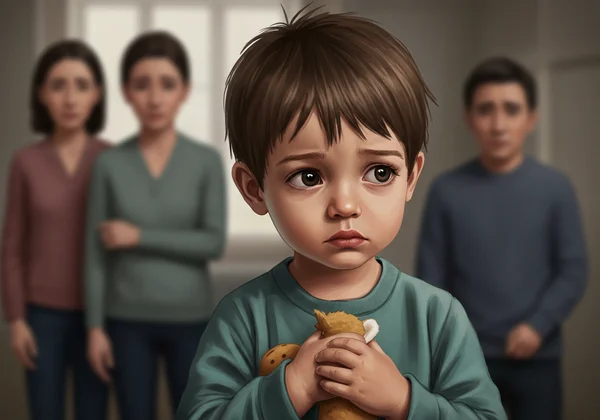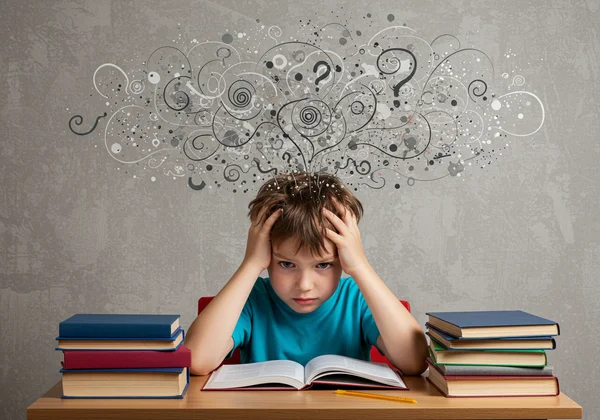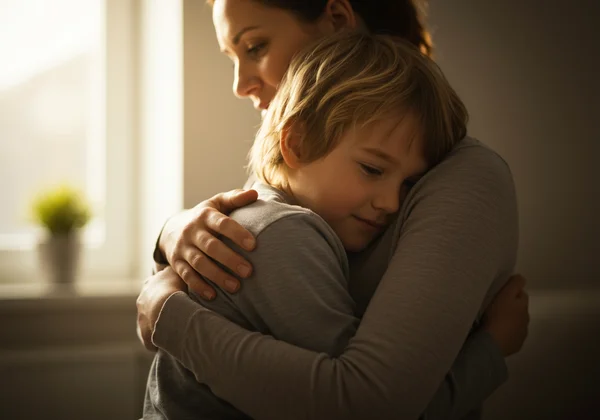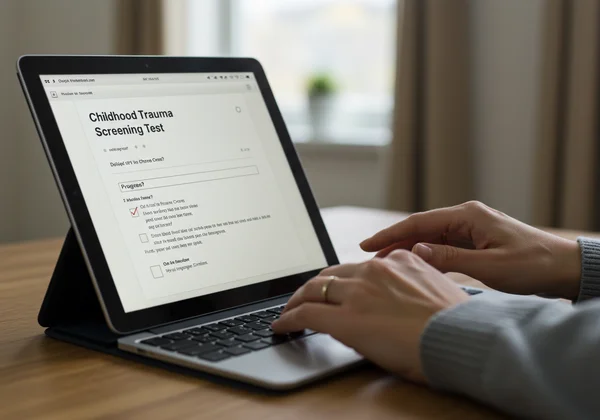Childhood Trauma Test & Signs: A Parent's Guide
As a parent or caregiver, your child’s well-being is your highest priority. It’s natural to feel worried when you notice significant shifts in their behavior or mood. While some changes are a normal part of growing up, others might be subtle indicators of something more profound. Understanding childhood trauma signs is the first, most crucial step toward providing the support your child needs. How do I know if my child has trauma? This guide is designed to help you navigate this complex question with compassion and clarity, empowering you to create a path toward healing.
Children experience the world differently than adults, and their reactions to distressing events can be varied and confusing. These events don't always have to be what we traditionally think of as "big T" traumas; they can stem from experiences like bullying, family conflict, or a sudden loss. The key is not the event itself, but how it impacts your child’s sense of safety and well-being. Gaining insight can feel overwhelming, but tools like an initial screening tool can offer a structured starting point for your understanding.
Understanding Childhood Trauma Signs: Behavioral & Emotional Clues
When a child's world feels unsafe, their behavior and emotions are often the first things to change. These clues are their way of communicating distress when they don't have the words. Paying close attention to these shifts is vital for early recognition and support. It helps you see beyond a "difficult phase" to the underlying cause.

Common Behavioral Changes After Trauma
A child’s behavior is a window into their inner world. After a traumatic event, you might observe sudden or gradual changes that seem out of character. For younger children, this can manifest as regression, where they revert to earlier behaviors like bedwetting or thumb-sucking. They might become unusually clingy or, conversely, withdrawn and isolated from friends and family.
Older children and teens might exhibit increased irritability, aggression, or defiant behavior. Their play might become repetitive, sometimes re-enacting parts of the traumatic event. You might also notice a loss of interest in activities they once loved or a sharp decline in school performance. These behavioral signals are not signs of a "bad kid" but rather a child struggling to cope with overwhelming experiences.
Emotional Responses and Their Meanings
Emotional volatility is a hallmark of a trauma response. Your child might seem to have an overblown reaction to minor stressors, shifting from intense anger to deep sadness in moments. They may live with a pervasive sense of fear, anxiety, or helplessness that they can't explain. Many children develop a heightened state of watchfulness, always on alert for potential danger.
Feelings of shame and guilt are also common, as children may internalize blame for the traumatic event. They might say things like, "It was my fault," or express a sense of being permanently damaged. Recognizing these emotional responses for what they are—attempts to make sense of a confusing and painful experience—allows you to respond with empathy instead of frustration.
Recognizing Child PTSD Symptoms Beyond the Obvious
While the behavioral and emotional clues are important, some child PTSD symptoms are less apparent but equally significant. These can manifest physically and have a profound impact on a child’s long-term development. Looking beyond the obvious signs helps create a more complete picture of what your child is going through. If you're concerned about these patterns, a childhood trauma test can help organize your observations.
Physical Manifestations of Stress and Trauma
The mind and body are deeply connected. Unresolved trauma often "lives" in the body, leading to physical symptoms that have no clear medical cause. Your child might complain of frequent headaches, stomachaches, or general fatigue. Sleep disturbances are very common, including nightmares, difficulty falling asleep, or waking up frequently throughout the night.
This state of chronic stress, known as hyperarousal, can also lead to a jumpy or exaggerated startle response. The body is stuck in a "fight, flight, or freeze" mode, unable to relax and feel safe. These physical signs are not for attention; they are genuine physiological responses to psychological pain.
Impact on Development and Learning
Trauma can disrupt a child's developmental trajectory. The constant stress impacts brain development, particularly in areas responsible for memory, emotional regulation, and executive function. As a result, children may struggle with concentration, problem-solving, and retaining new information at school.

This can be misidentified as a learning disability or ADHD, when in fact it is a direct result of the brain prioritizing survival over higher-level learning. Understanding this connection is vital for advocating for your child's needs in an academic setting. Addressing the root trauma is key to unlocking their full potential for growth and learning. Exploring an ACEs test framework can provide further insight into the long-term effects.
How to Help a Traumatized Child: Creating a Safe Haven
Knowing the signs is the first step; responding with effective support is the next. Your role as a parent or caregiver is to be a safe harbor in your child's emotional storm. You don’t need to have all the answers. Your primary goal is to help a traumatized child feel seen, heard, and secure. Creating this foundation of safety is the most powerful gift you can offer on their healing journey.

Essential Strategies for Parental Support
The most important thing you can offer is a consistent, predictable, and loving environment. Re-establishing a sense of safety is paramount. Maintain regular routines for meals, homework, and bedtime, as predictability helps calm a nervous system in overdrive. Offer physical comfort when appropriate, like hugs or a hand on their shoulder, but always respect their boundaries if they pull away.
Listen without judgment. Let your child share their feelings at their own pace, without pressing for details they aren't ready to disclose. Validate their emotions by saying things like, "That sounds really scary," or "I understand why you're so angry." This validation tells them their feelings are legitimate and that they are not alone.
Building Resilience and Coping Skills
Alongside creating safety, you can empower your child with tools to manage their overwhelming feelings. Teach them simple grounding techniques. For example, the "5-4-3-2-1" method involves naming five things they can see, four things they can touch, three things they can hear, two things they can smell, and one thing they can taste. This pulls them out of distressing thoughts and back into the present moment.
Encourage activities that promote self-expression, like drawing, writing, or playing music, which can help them process emotions they cannot verbalize. Fostering resilience isn’t about "toughening them up"; it's about providing the tools and support they need to navigate their inner world. Remember, healing is a process, and your unwavering support makes all the difference.
When to Consider a Trauma Test for Kids
While your observations and support are invaluable, sometimes an objective tool can provide much-needed clarity. A trauma test for kids is not meant to diagnose but to serve as a preliminary screening. It can help you structure your concerns and decide on the next steps, acting as a bridge between your parental intuition and professional guidance.

The Role of Preliminary Screening Tools
Screening tools like our free, anonymous assessment are designed to identify potential symptoms related to psychological trauma. By answering a series of scientifically designed questions, you can get an immediate report on your child's potential risk level. This can validate your concerns and give you a clearer language to use when discussing the situation with your child, your family, or a professional.
Think of it as a first-step resource. It helps organize complex and confusing behaviors into a more understandable framework. This can reduce feelings of uncertainty and empower you to take informed action. The goal is not to label your child but to open a gateway to understanding. A free online test is an accessible and private way to begin this process.
Why Professional Help is Key: Beyond Screening
It's important to remember that an online screening isn't a substitute for a professional diagnosis. The results from a tool like the Trauma Test can provide valuable initial insights, but only a qualified mental health professional can conduct a comprehensive evaluation and create a tailored treatment plan.
A therapist specializing in childhood trauma can provide evidence-based therapies that help children process their experiences in a safe and supportive environment. They can also offer guidance to you, the parent, on how to best support the healing process at home. Use the screening as a tool to start the conversation, not end it. Your love, combined with professional expertise, creates the strongest foundation for your child's recovery.
Disclaimer: This article is for informational purposes only. The Trauma Test tool is a preliminary screening resource and is not a substitute for professional medical or psychological advice, diagnosis, or treatment. If you have immediate concerns about your child's safety, please contact a local crisis hotline or emergency services.
Your Child's Path to Healing Starts with Understanding
Recognizing the signs of childhood trauma is a profound act of love. It requires patience, compassion, and the courage to look at painful realities. By understanding the behavioral, emotional, and physical manifestations, you can respond to your child's needs with informed empathy. You can create a safe haven where they feel secure enough to begin healing.
Remember, you are not alone on this journey. Resources are available to guide you, from informational articles like this one to accessible screening tools. Taking that first step toward clarity can be empowering for both you and your child. If you feel ready to gain more insight, you can take the first step on our homepage with a confidential and free assessment. Your understanding is the light that guides your child out of the darkness.
Frequently Asked Questions for Concerned Parents
How do I know if my child's behavior is trauma-related or just "a phase"?
While all children go through phases, trauma-related behaviors are typically more intense, persistent, and often linked to a noticeable shift after a specific event or period of stress. Key differentiators include regression to earlier behaviors, re-enacting distressing events in play, and a pervasive sense of fear that interferes with daily life. If the behaviors are severe and persistent, it’s worth exploring further.
What does unresolved childhood trauma look like in teens?
In teenagers, unresolved trauma can manifest as increased risk-taking behavior, substance use, self-harm, social withdrawal, or intense mood swings. They might also show signs of a poor self-image, struggle with relationships, and exhibit a cynical or hopeless outlook on the future. The core emotional turmoil is similar to younger children but is expressed through more adult-like, and often riskier, behaviors.
Can a trauma test for kids provide a diagnosis?
No, a trauma test for kids like the one offered on our site is a screening tool, not a diagnostic instrument. It is designed to identify potential symptoms and indicate a risk level (low, medium, high) to help you decide if further action is needed. A formal diagnosis of PTSD or other trauma-related disorders can only be made by a qualified mental health professional after a comprehensive evaluation. We encourage you to use our free tool as a starting point for a conversation with a professional.
How can I talk to my child about what they're experiencing?
Choose a calm, private moment when you won't be interrupted. Start by sharing your own observations in a non-judgmental way, such as, "I've noticed you seem sad lately, and I'm worried about you." Let them lead the conversation and don't push for details. The most important message to convey is that you love them, you are there for them, and you will get through this together.